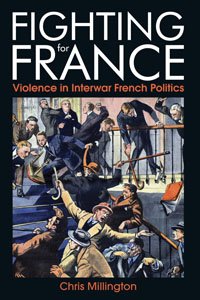Scuffles and skirmishes in interwar French politics
by Chris Millington
- Date
- 27 Mar 2018

The print version of this article can be downloaded as a PDF file.
Dr Chris Millington is Senior Lecturer in History at the University of Swansea. He was a British Academy Postdoctoral Fellow, 2010-2012.
Violence has no place in a democracy. Or does it? In my book, Fighting for France: Violence in Interwar French Politics, I pose a number of questions about the role of political violence in a democratic society. Taking the period of the late Third Republic as a case study, I examine violent confrontations between members of the extremes of right and left – as well as fighting with police – in settings ranging from the street to the factory floor. How did political groups understand and represent their own violence and that of their opponents? Why did some French believe that violence was an acceptable form of action, when more democratic means of political campaigning were available? Though democracy may channel political confrontation into the ballot box, violent subcultures can be difficult to dislodge.
Political conflict split the French nation during the interwar years. On the right, paramilitary groups known as ‘leagues’ sought to mobilise their members in a violent campaign against the democratic Third Republic. The largest of these leagues was Colonel François de La Rocque’s Croix de Feu. By 1936, the Croix de Feu had close to 500,000 members. Its huge paramilitary displays impressed right-wing opinion and terrified the left. On the left, the communist party enlisted the working classes in the cause of proletarian revolution. Taking its orders from Moscow, the party was at the heart of the 1930s antifascist campaign against the leagues. It organised large counter-demonstrations to league meetings, a tactic known as ‘mass self-defence’.
Historians of interwar violence tend to focus on two incidents of mass confrontation. On 6 February 1934, the leagues mobilised their members in Paris against the left-wing government which was mired in a corruption scandal. Leaguers made repeated attempts to break into the French parliament. Police killed over a dozen demonstrators as they tried to quell the unrest. Police were once again responsible for the deaths on 16 March 1937 in the Parisian suburb of Clichy. On this occasion, an antifascist counter-demonstration to a league meeting descended into fighting between antifascists and constables. Police lines came under pressure as left-wingers attempted to invade the meeting. Panicked officers opened fire on the mob, killing five, while demonstrators beat to death a police constable.
Beyond these two significant incidents, in the interwar period France appears relatively peaceful in comparison with Germany and Italy, where bloody street-fighting between communist and fascist groups led to hundreds of deaths. But compared with another stable parliamentary democracy, Great Britain, where no one is recorded to have died in political violence, France does appear more violent. Scuffles and skirmishes between political opponents were doggedly persistent, and there were around 70 fatalities during the 1920s and ’30s.
Each day, political groups vied with each other for the control of public space. They wore uniforms, gave salutes, and marched through towns and cities in an effort to mark out sections of territory as their own. Teams of propagandists laid claim to an area with posters, while tearing down those of their opponents. Newspaper sellers, accompanied by large groups of their comrades, plied their trade, often in locations deemed to be in the hands of the enemy. Territorial disputes led to numerous violent altercations. Political groups on the left and right shared a keen sense of ownership. Left-wingers staked a claim to localities with large working-class populations and left-wing town councils. Right-wingers considered middle-class districts their own. But it was common for activists to enter their opponents’ territory deliberately in order to lay down a challenge to the enemy. The aim was not to take the area for themselves, but rather to make a heroic appearance before withdrawing. Such invasions were rarely tolerated, and a violent response was deemed necessary to re-establish a group’s honour.
There was, however, no single recipe for violence. Violent incidents were impossible to predict. Certainly, political groups could increase the likelihood of violence. If a group’s newspaper sellers traversed the streets with armed bodyguards, fighting with the enemy often occurred. Some French mayors even banned the sale of newspapers in the street because this type of violence was so frequent. However, on other occasions, rival activists could work alongside each other peacefully. In the meeting hall, speakers were vulnerable to attack from the audience; yet even the stormiest of meetings could end without violence. Police were often unable to determine the causes of violent incidents, especially when uncooperative witnesses hampered investigations. The authorities themselves could spark clashes, in particular if they had not taken steps to put in place adequate policing of a demonstration. Even the weather could exacerbate a volatile situation: at Limoges in November 1935, driving rain and pitch darkness meant that a group of right-wingers were unable to see the constables protecting them from a left-wing mob. Fearing that they were undefended against their bloodthirsty opponents, the frightened men drew their revolvers and fired into the crowd.
When violence did erupt, the authorities were prepared to tolerate low-level fighting as long as something more serious did not break out. In September 1934, for example, the deputy-prefect in Aubusson (Creuse) reported on a communist meeting held at the town’s labour exchange. He wrote in his report: ‘The session began at 9pm, and came to an end at 11pm without any notable incident: some quite violent altercations, some punches were exchanged between listeners of different opinion and that was all’. Permissive attitudes to violence informed police culture. Both constables on the beat and the specialised riot police units enjoyed a reputation for gratuitous brutality. Third Republican authorities had attempted to pacify the police force of the Second Empire (Republicans had had first-hand experience of police violence) through an education programme that underscored the newly-acquired democratic rights of citizens. Still, the daily encounters between officers and political activists were difficult to control. Constables were instructed to ‘jostle people with a smile’, but they frequently resorted to their fists, hob-nailed boots and batons to disperse recalcitrant militants. Political activists gave as good as they got: to knock down a constable was a marker of one’s courage; all the better if his hat was stolen as a trophy.
In the wake of violence, political groups on the left and the right drew on a number of well-established narratives to explain their action and that of their opponent. When attacked, groups always claimed that they had faced overwhelming odds (usually to the order of twenty-to-one). It was said that communists attacked in the dark, ambushing their right-wing enemies. Meanwhile, right-wingers were reported to load their leather gloves to inflict maximum damage on the adversary. These devices allowed political groups to expose the apparent cowardice of an enemy who did not fight fairly face-to-face. To attack itself was considered a sign of weakness, because rage, anger and loss of self-control were understood as feminine qualities. ‘Real men’ maintained their sang-froid at all times, even in the face of intolerable provocation.
However, once attacked, defensive violence was legitimate. It was framed as a necessary – and manly – corrective to the enemy’s unacceptable and unmanly behaviour. Even disproportionate violence was permitted in the name of self-defence; an oft-used slogan of all groups was: ‘For one eye, both eyes. For one tooth, the whole filthy mouth.’ For this reason, all sides invariably claimed that their violence was defensive. This was not just a face-saving tactic. Contemporary understandings of self-defence permitted pre-emptive attack if threatened. Popular self-defence manuals thus advised that, if one felt threatened in the street, ‘it’s better to kill the Devil than be killed by him.’ Consequently, political activists considered their action defensive, even when they went on the attack. Such action was deemed perfectly acceptable according to the standards of the time. Indeed, when men went on trial for killing a political opponent, they were often acquitted by the jury if they could prove that they had perpetrated their violence according to such standards.
Fighting for France reveals that democracy cannot entirely eliminate the recourse to violence. Rather, violent cultures can exist alongside democratic politics. Even democratic societies understand that there are certain rules to violence that act to restrain and enable confrontation. In the case of interwar France, deeply entrenched understandings of acceptable manly conduct informed these rules. Such understandings ran as deep as the French commitment to democracy and were therefore difficult to eradicate. Violent incidents, if interpreted and represented in a certain way, were thus deemed justifiable in the minds of an audience far greater than the memberships of violent political associations.

How are we doing? Your feedback is important to help us shape future issues of the British Academy Review.
To provide reader feedback, please visit www.britishacademy.ac.uk/british-academy-review-feedback